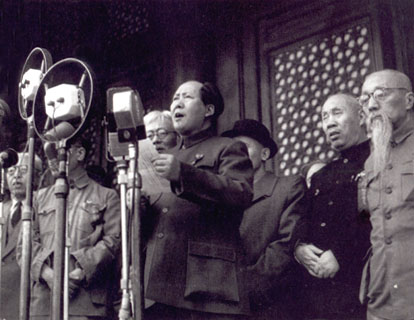 |
This is a file from the Wikimedia Commons. Information from its description page there is shown below.
Commons is a freely licensed media file repository. You can help.
|
Summary
| DescriptionChina, Mao (2).jpg |
Español: Imagen de Mao Zedong proclamando la fundación de la República Popular China en la Puerta de Tian'anmen de la Ciudad Prohibida de Pekín el 1 de octubre de 1949.
English: Pictured here is former Chinese Chairman Mao Zedong announcing the founding of the People's Republic of China on October 1 1949.
Italiano: Immagine di Mao Tse-tung che proclama la nascita della Repubblica Popolare Cinese l'1 ottobre 1949
Bân-lâm-gú: 1949-nî Tiong-kok Tiong-iong Jîn-bîn Tsìng-hú tsú-si̍k Môo Ti̍k-tong tī khai-kok tāi-tián suan-pòo Tiong-huâ Jîn-bîn Kiōng-hô-kok tsìng-sik kiàn-li̍p. 1949年中國中央人民政府主席毛澤東佇開國大典宣布中華人民共和國正式建立。
|
| Date |
10/1/1949 |
| Source |
Sina.com < search.sina.com.cn? not found the first 10 resultpages) |
| Author |
Unknown |
Permission
( Reusing this file) |
| Public domainPublic domainfalsefalse |
 |
This image is now in the public domain in China because its term of copyright has expired. According to copyright laws of the People's Republic of China (with legal jurisdiction in the mainland only, excluding Hong Kong and Macao) and the Republic of China (currently with jurisdiction in Taiwan, the Penghu, Kinmen, Matsu, etc.), all photographs and cinematographic works, and all works whose copyright holder is a juristic person, enter the public domain 50 years after they were first published, or if unpublished 50 years from creation, and all other applicable works enter the public domain 50 years after the death of the creator.
To uploader: Please provide where the image was first published and who created it or held its copyright.
|
|
|
File usage
The following pages on Schools Wikipedia link to this image (list may be incomplete):
SOS Children's Villages aims to make Wikipedia suitable for young learners. SOS Children believes education is an important part of a child's life. That's why we ensure they receive nursery care as well as high-quality primary and secondary education. When they leave school, we support the children in our care as they progress to vocational training or higher education. Why not try to find out more about sponsoring a child?




